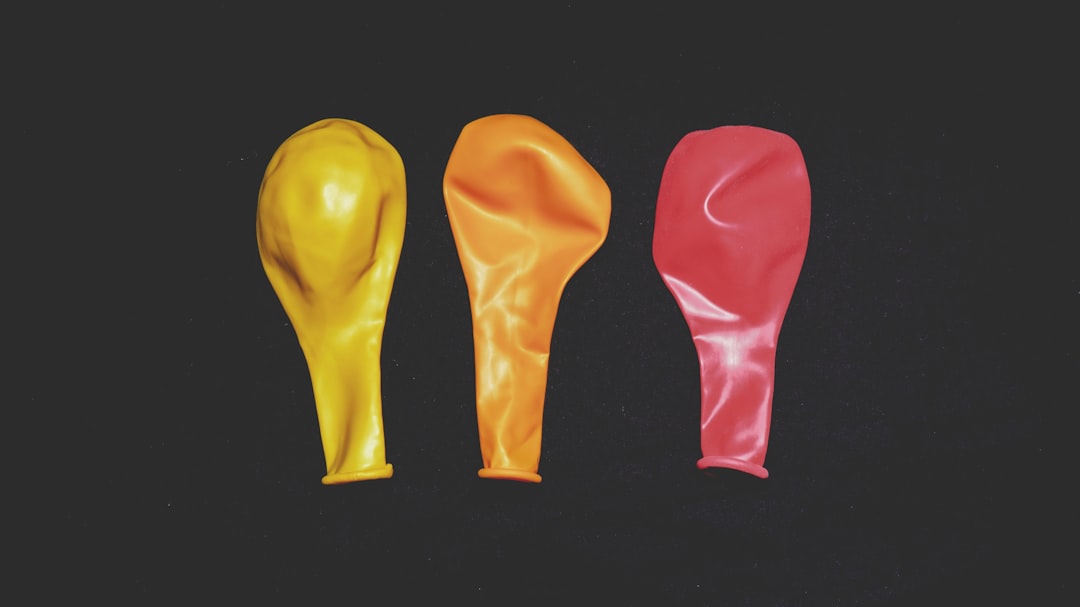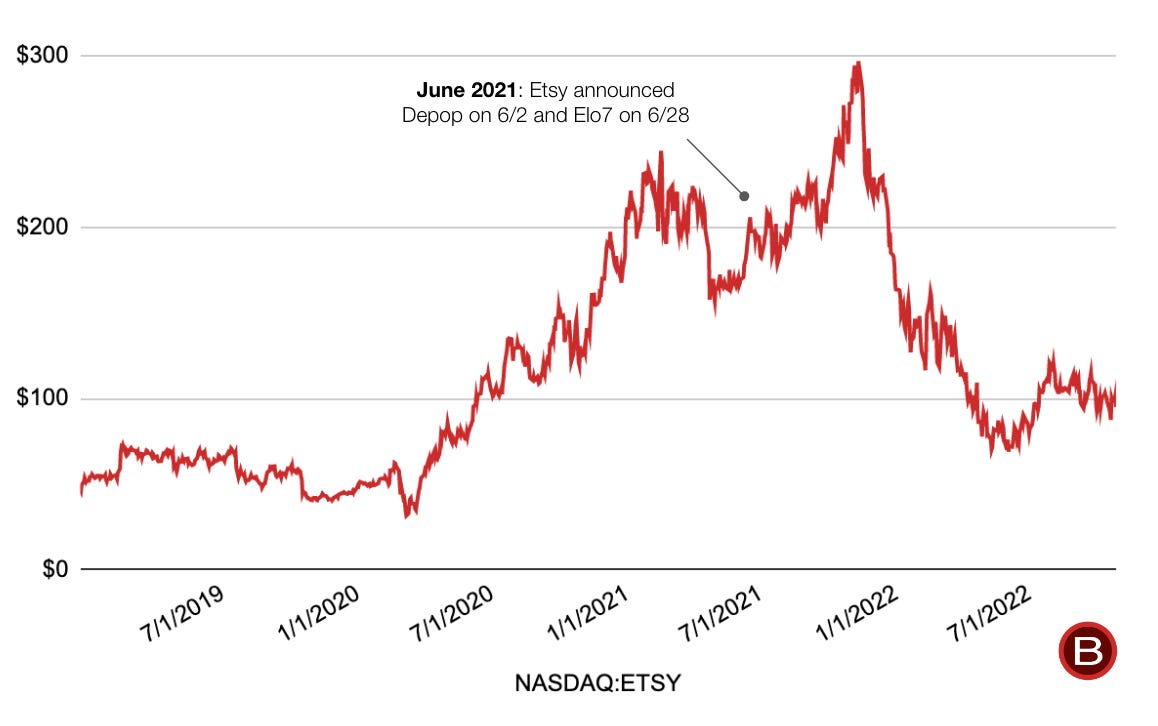#147 - Depopped
The Importance of Timing
Hi 👋 - Last week, Etsy took a $1 billion write-off on Depop and Elo7, two acquisitions made - with the benefit of hindsight - at the top of the market in 2021. Today, a look at M&A and market cycles through the lens of Etsy’s pandemic acquisitions. As always, thanks for reading.
If you’re finding this content valuable, consider sharing it with friends or coworkers. 🎈
For more like this once a week, consider subscribing. 🎈
Venmo 2.0
From jokes to break-ups to jumping rope1, timing is crucial to many areas of life. It’s crucial for M&A too.
On June 2, 2021, Etsy acquired Depop, an apparel resale marketplace focused on vintage, streetwear, and early 2000s fashion, for $1.625 billion in cash. Since its launch in 2011, Depop amassed over 30 million registered users (emails on file), four million active buyers, and two million active sellers. The service is popular with Gen Z; 90% percent of users are under 26. Like Poshmark, Depop integrates elements of social media into its shopping experience. At the time of the acquisition, Depop had 140,000 followers on TikTok, almost an order of magnitude higher than Etsy at 16,000 and Snap used Depop as an advertising case study2. Purchase frequency is high, about six orders per year (that’s catnip to e-commerce executives)3. In 2020, GMS4 and revenue were $650 million and $70 million respectively, both growing 100% year-over-year, aided by the pandemic e-commerce boom. Strategically, Depop fortifies Etsy’s apparel category, which accounted for about 10% of 2020 GMS, and provides a beachhead in the rapidly growing, but hypercompetitive, fashion resale market. Here’s CEO Josh Silverman describing the deal in August 20215:
We believe Depop is the best asset in the resale space, given its high user engagement metrics. The U.S. secondhand market opportunity is projected to double to $77 billion by 2025. And the resale portion of secondhand is forecasted to grow 11x faster than retail clothing for the next five years. We're also seeing that young consumers are adopting secondhand fashion faster than any other audience. And Depop is the tenth most-visited shopping site among Gen Z consumers in the U.S. In fact, we think Depop is potentially to Etsy like Venmo was to PayPal, a new way to shop for the new generation.

A few weeks later, Etsy acquired Elo7, a Brazilian marketplace for custom and made-to-order goods, for $217 million. Strategically, Elo7 gives Etsy a foothold in Latin America, a region dominated by homegrown Mercado Libre, that American e-commerce firms have struggled to penetrate. The deals advance Etsy’s House of Brands M&A strategy, bolstering its anti-Amazon credentials.
What A Difference A Year Makes
In early November 2022, Etsy took a $1 billion impairment charge, eliminating all goodwill carried on its books for Depop and Elo7. Goodwill is an intangible asset created by M&A, reflecting the difference between acquisition price and the fair value of the assets acquired. It reflects intangibles like brand strength, competitive advantages, and intellectual property, that are valuable, but difficult to quantify. From an accounting perspective, 25% of what Etsy paid for Depop was attributed to assets like trademarks, customer relationships, and technology, while the remaining 75% was goodwill:
Similarly, goodwill represented over 70% of Elo7’s purchase price:
Unlike a computer or toaster oven, which are amortized over a finite lifespan, goodwill is assumed to have an indefinite useful life. For example, brands like Coca-Cola or Hermes have been valuable for centuries. However, there’s no free lunch in accounting and most brands aren’t Coca-Cola. To account for this, companies must test goodwill for impairment annually. This test answers the question, “is the acquired company worth at least as much as when we bought it?” If yes, nothing happens. If no, goodwill is impaired and needs to be written down. One way of assessing impairment is – like everything else in finance – comparing the net present value of expected cash flows from the business today versus at the time of acquisition.
A lot can change in a year. The e-commerce operating environment today is drastically different than it was in 2020 or 2021. A laundry list of changes drove the impairment: adverse macroeconomic conditions, including reopening and inflationary pressures on discretionary spending, executive management changes at Depop and Elo7, downward revisions to business forecasts, and rising interest rates (which depress the value of future cash flows in a DCF)6. This chart strikes again:

Farewell, Robinhood
When Etsy acquired Depop and Elo7, it had the wind at its back. GMS was $3.0 billion in Q2 2021, 13% above Q2 2020 and more than double pre-Covid levels. The pandemic dealt Etsy pocket aces, and the company played its hand aptly. More generally, tech was on the upswing in 2021 – growth was heady, valuations were frothy, and animal spirits were running hot. The IPO market was booming; Robinhood was still a thing. Extrapolation comes easy and greed and fear are part of human nature. As former Citigroup CEO Chuck Prince said in 2007:
As long as the music is playing, you’ve got to get up and dance.
Yet as distressed credit investor Howard Marks points out, nothing in investing is as dependable as cycles7:
Ignoring cycles and extrapolating trends is one of the most dangerous things an investor can do. People often act as if companies that are doing well will do well forever, and investments that are outperforming will outperform forever, and vice versa. Instead, it’s the opposite that’s more likely to be true.
Etsy acquired Depop and Elo7 near the top of the market, as Silverman recently acknowledged8:
In hindsight, given what we've seen happen to technology and consumer company valuations as well as macro business headwinds and other factors such as rising interest rates, our timing on those acquisitions certainly could have been better.
With shares of online marketplaces down 50% or more in 2022, Etsy might have been able to snag Depop and Elo7 for a fraction of what they paid in 2021. This is easy to say in hindsight, but impossible to say prospectively. The future is a web of probability distributions and alternative paths. If a butterfly in Brazil flapped its wings differently, the deals might have worked out.
We know two things for certain. First, the near future often looks like the recent past. Second, that this isn’t always the case. Since nothing goes in one direction forever (see: US e-commerce penetration), Marks argues it’s crucial to ascertain where you are in the market cycle and act accordingly9. The future is still unknowable, but taking the market's temperature helps determine if it’s a good time to place a bet. Characteristics like low interest rates, high valuations, easy capital, and a vibrant economy mean that prospective returns are likely to be low. In this case, better to save your chips for a more favorable environment (of course, this is easier said than done; see: human nature and FOMO). Mark’s framework for taking the market’s temperature is below. When the column on the left is more descriptive of the current market environment, be weary.
Running a business is hard. M&A is hard. Successful M&A is even harder. It involves courtship, successful integration, the right valuation, cultural and strategic alignment, and good execution. Only a handful of companies like Amphenol, Constellation Software, and Heico do it consistently well. Even fantastic capital allocators don’t bat 1.000. Warren Buffett famously stuck out on Precision Castparts.
For many 2021 tech investments, the column on the left of Mark’s checklist dominated. Etsy’s not the only company likely to have goodwill impairment. Conversely, with the right-hand side seeing more action in 2022, the conditions for value-enhancing M&A are improving. It’s all a matter of timing.
If you’re finding this content valuable, consider sharing it with friends or coworkers. 🎈
For more like this once a week, consider subscribing. 🎈
More Good Reads and Listens
Howard Marks on market cycles. Vox on Etsy’s acquisition of Depop. Below the Line on Etsy’s House of Brands M&A strategy.

Thanks, Massa!
Vox, Why Etsy dropped $1.6 billion on Depop, June 2, 2021.
Etsy, Etsy to acquire global fashion resale marketplace Depop, June 2, 2021.
GMS stands for gross merchandise sales, a measure of value of all transactions that occur on an online marketplace in a given time period.
Etsy, Q2 2021 Earnings Call, August 4, 2021.
Etsy, Q3 2022 10Q, November 2, 2022.
Howard Marks, The Most Important Thing: Uncommon Sense for the Thoughtful Investor, 2011.
Etsy, Q3 2022 Earnings Call, November 2, 2022.
Howard Marks, The Most Important Thing: Uncommon Sense for the Thoughtful Investor, 2011.






